Ducks around the world come in different colors. For some species, coloring is much more than a simple physical trait. Plumage colors can influence breeding success in different species of ducks.
Some of the ducks with black heads in the world are males. They have plain backs or a multicolored mostly black head.
The result of a head in a different color is potentially attracting more female partners or attracting a single female partner faster.
Some of the world regions where these ducks are found include The Americas, Africa, Australia, Europe, and Asia.
Ducks with blackheads are even found in Antarctica. Here are some of the species with their most important physical traits.
Table of Contents
1. Common Merganser
One of the most common ducks with black heads in the world are sea ducks. Among them, Common Mergansers (Mergus merganser) are known to many due to their common nature and appearance that combines black and white colors.
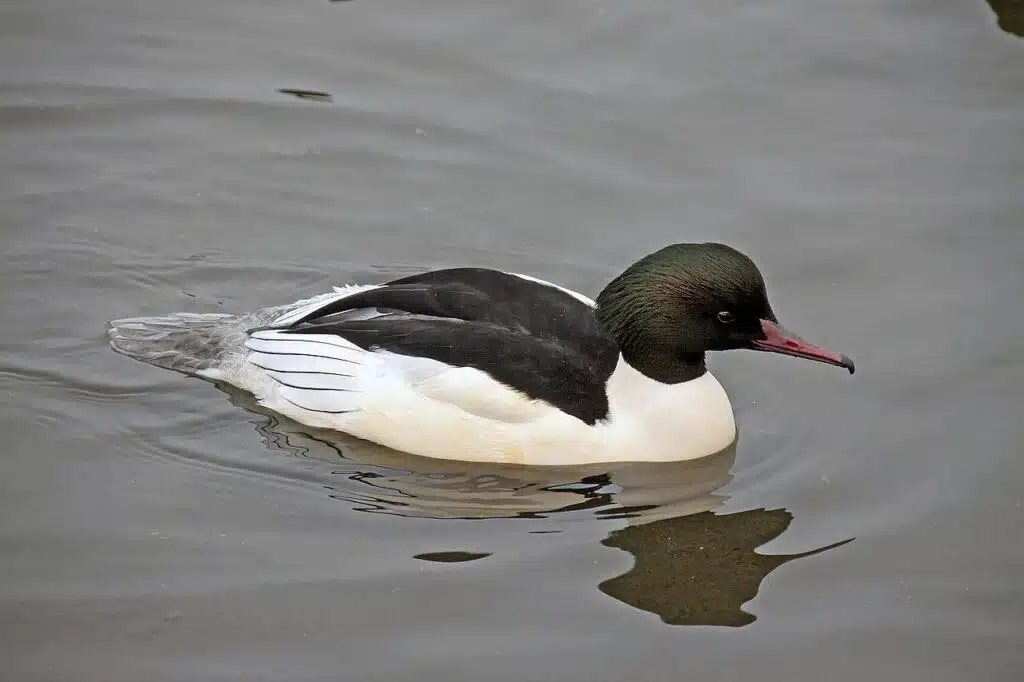
These types of seaducks are separated between males and females by the coloring of their heads.
Males, in their breeding plumage, show a black head with black a slight green tinge.
They also have a black crest or long black feathers, a commonality among Mergansers.
The black head of the male is backed by black features on the upper back while much of its plumage remains white.
Females also have a darker head. A brown head and not a black head is specific to The Female Merganser.
Interesting fact – the crest of The Common Merganser is never fully erect.
Range – North America, Europe, Asia
2. Black-headed Duck
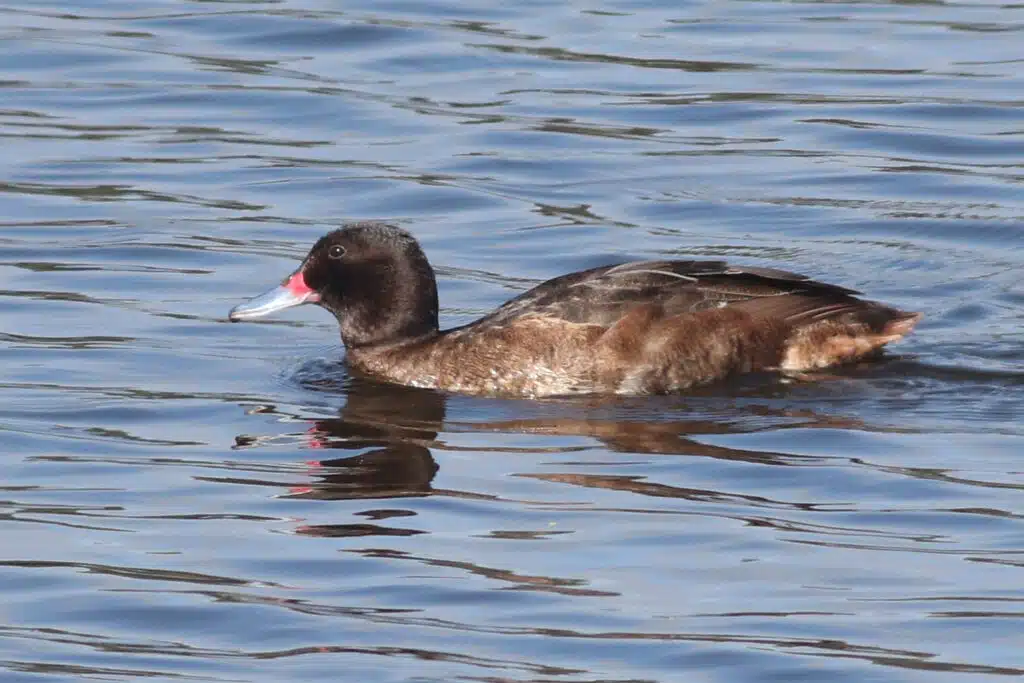
Black-headed Ducks (Heteronetta atricapilla) are South American natives with differentiating colors between males and females.
Only the males of the species have a black head while females have a brown head.
The male head and neck are black, with or without a glossy appearance.
Brown and cinnamon nuances are also specific to these ducks. Cinnamon is a brighter nuance, known to the underbelly of the ducks, both in the case of males and females.
From Chile to Bolivia, this type of duck dives. A black head is common on many types of diving ducks both within and outside South America.
Interesting fact – Female Black-headed Ducks only lay eggs in pre-existing bird nests of other species.
Range – Bolivia, Chile, Paraguay
3. Red-breasted Merganser
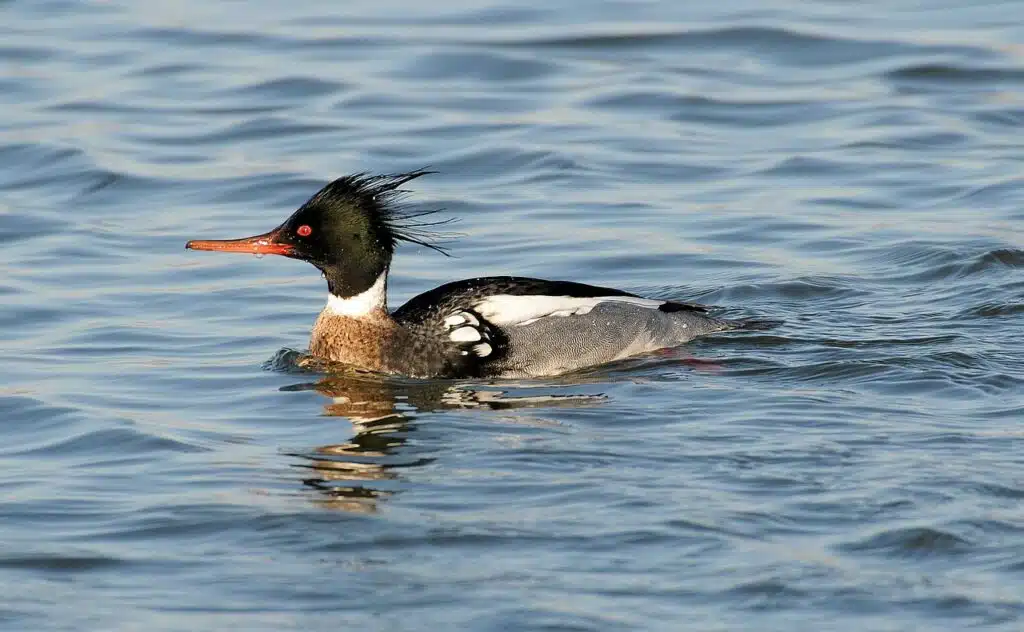
A species of The Northern Hemisphere, Red-breasted Mergansers (Mergus serrator) are known for their red-brown chests.
While their heads don’t inspire their name, these are ducks that also come with a black head.
The male of the species features a black head and a sometimes visible black crest, as with most Mergansers.
Females have brown heads of various nuances and they are dominated by dull colors as opposed to the brown, red-brown, black, and white males.
Both males and females are known for their vocalizations. These are different from males to females.
One of the best areas to spot these types of ducks in The US includes Eastern coastlines in the winter.
Interesting fact – A wintertime migration to coastlines is specific to Red-breasted Mergansers.
Range – North America, Northern Europe, Asia
4. Common Goldeneye
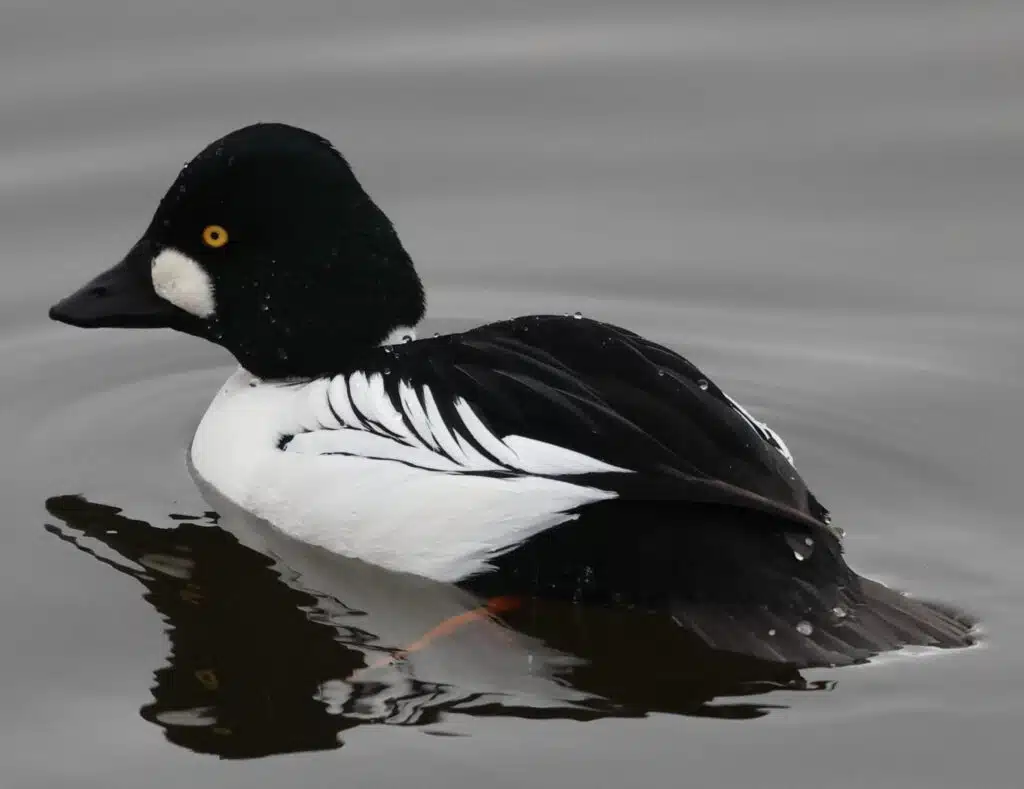
The colors of ducks and sea ducks such as those of The Common Goldeneyes (Bucephala clangula) are the first traits to inspire the name of a species.
In this case, it’s the yellow eyes of male and female ducks that inspire these ducks’ names.
Apart from rare yellow-golden eyes, these ducks with a wingspan of around 30 inches are also known for having black heads.
Males have black heads with a metallic green hue. They also show large white patches in the form of perfect circles under the eyes.
While females share the eye color with males, they show a dull brown head color.
Interesting fact – The emerged Common Goldeneye chicks follow females around for almost 2 months before flying out on their own.
Range – North America, Northern Europe, Asia
5. Lesser Scaup
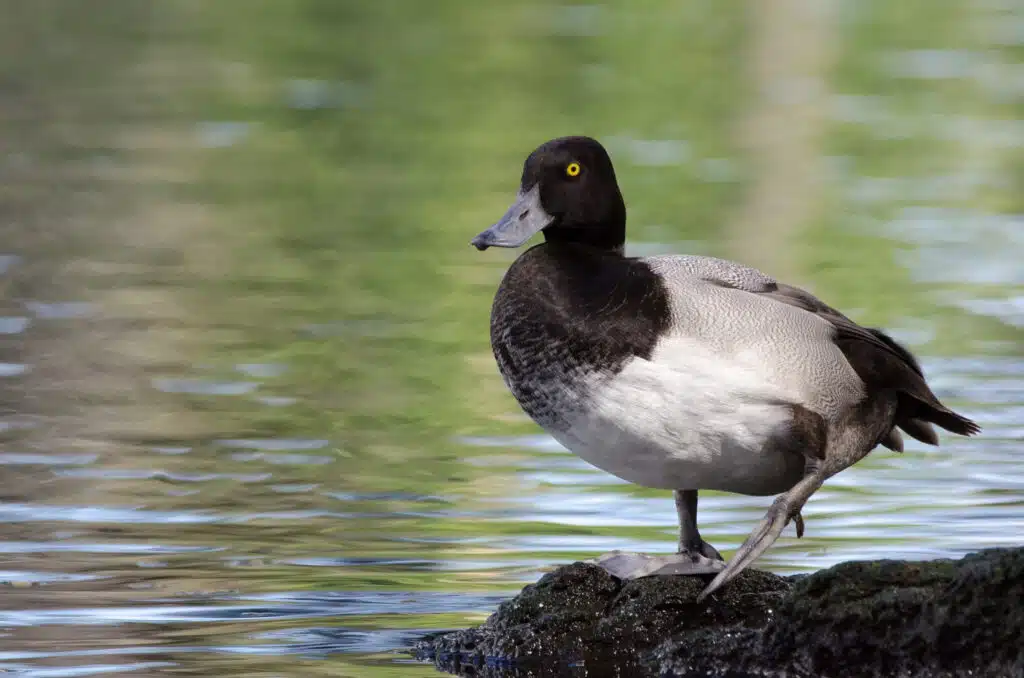
Lesser Scaups (Aythya affinis) are North American ducks of interesting heritage.
Some believe they are named after the seafood they eat. These types of ducks come in highly contrasting plumage, which includes a black head, on males.
There’s a black head with a green sheen with black and white plumage on males.
Females are dull-colored, showing a dark brown head without a sheen, and nuance changes going into the breeding season.
Lesser Scaups are found all across North America with some populations migrating as far as Central America.
Interesting fact – Lesser Scaups dive straight into the bottom mud for food.
Range – North America
6. Ring-necked Duck

Ring-necked Ducks (Aythya collaris) are some of the typical ducks of North American freshwaters.
From small ponds to larger lakes, these types of ducks inhabit territories in the North, West, and Southern parts of the continent.
Much of their appearance impacts their name. The male of the species has a cinnamon-brown nuance ring or band around the neck.
Its head and most of its neck are black and similar to other species which are further black, white, and gray.
These types of freshwater ducks with black heads aren’t divers. They only feed at the surface of the water where they are opportunistic.
They can eat anything from plants to small animals and may migrate for food.
Interesting fact – Young Ring-necked Ducks feed on insects they catch on water.
Range – North America
7. Greater Scaup
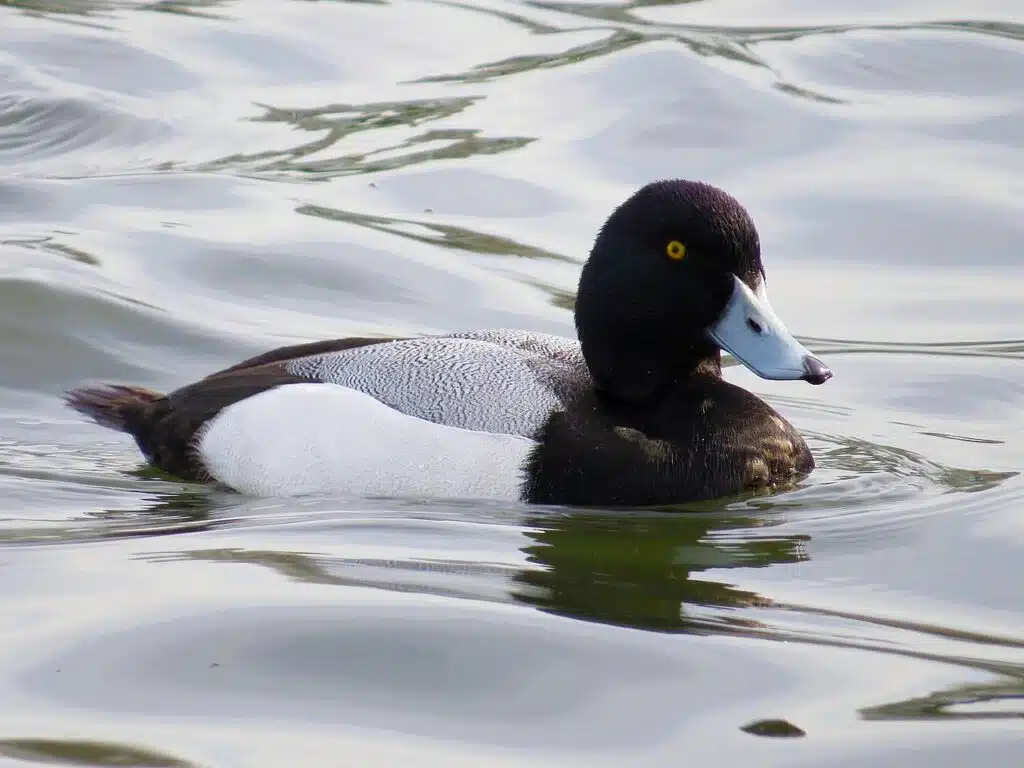
A species of diving duck, Greater Scaups (Aythya marila) also shows a black head.
Both males and females have evolved to have similar head coloring while the rest of the plumage mostly has a different nuance.
Males are dominated by black, white, and gray nuances. Apart from a black head, they also have matching black necks and chests while their backs and wings are gray, white, and black.
Females also show black chests but are mostly dominated by brown nuances.
Commonly breeding in the Northern limits of the continent (including Alaska), Greater Scaups then migrate to coastal areas to overwinter.
They can travel further South for warmer temperatures before returning to their breeding sites.
Interesting fact – Black heads of male Greater Scaup show a green sheen in the breeding season.
Range – Coastal areas of North America, Northern Europe, and Northern Asia
8. Tufted Duck
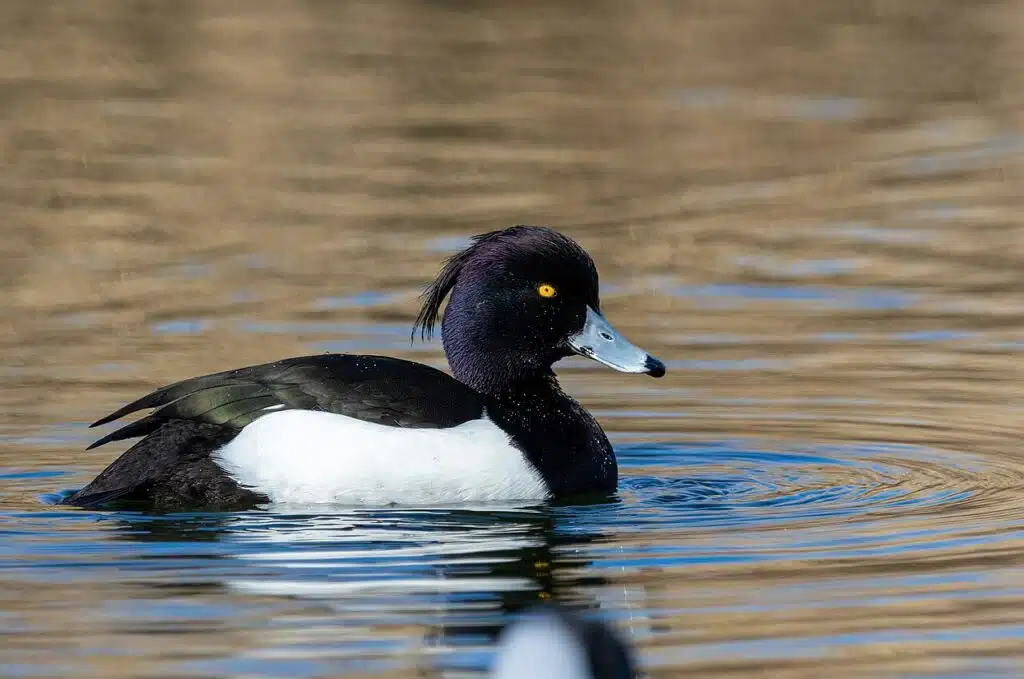
A type of seaduck, Tufted Ducks (Aythya fuligula) are known as black and white ducks.
Males show a black head and a black crest. This is a crest only found at the back of its head in the form of elongated feathers as it doesn’t sit erect.
A black chest and black upper wings are also specific to males of the species.
Yellow eyes are among the few physical traits these types of ducks share with females, which are dominated by brown or chestnut nuances.
A species of temperate climates, these ducks have brown chicks that mostly resemble females.
Interesting fact – Tufted Ducks live in flocks of up to a few thousand individuals.
Range – Europe, Asia, North America
9. Paradise Shelduck
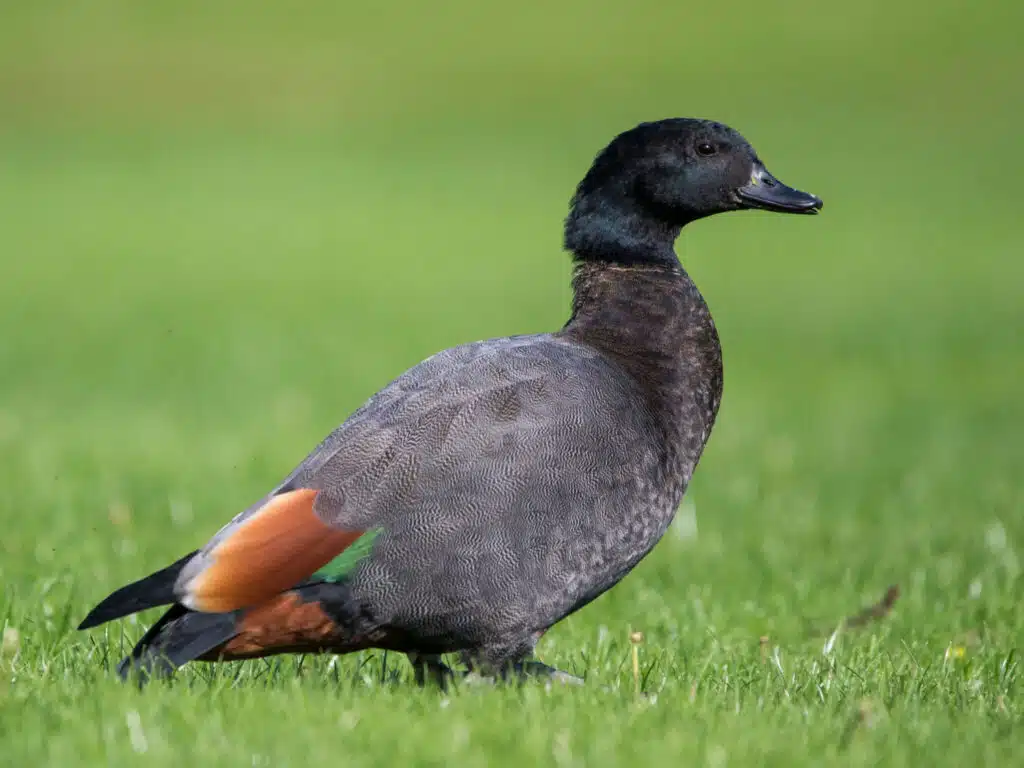
Over the years, Paradise Shelducks (Tadorna variegata) have been subject to many myths regarding their appearance.
The changing nuances of the species are influenced by the breeding season.
Still, there are certain facts about the species beyond debate. Males have a black head while females have a white head.
The male bird also has a black beak, chest, and underbelly, with additional dark gray and white plumage.
Females almost look like another species with their white heads and brown chests and bellies.
The female also has gray-brown plumage and dark gray wing tips.
Interesting fact – Paradise Shelduck chicks are mostly black and white.
Range – New Zealand
10. Yellow-billed Duck
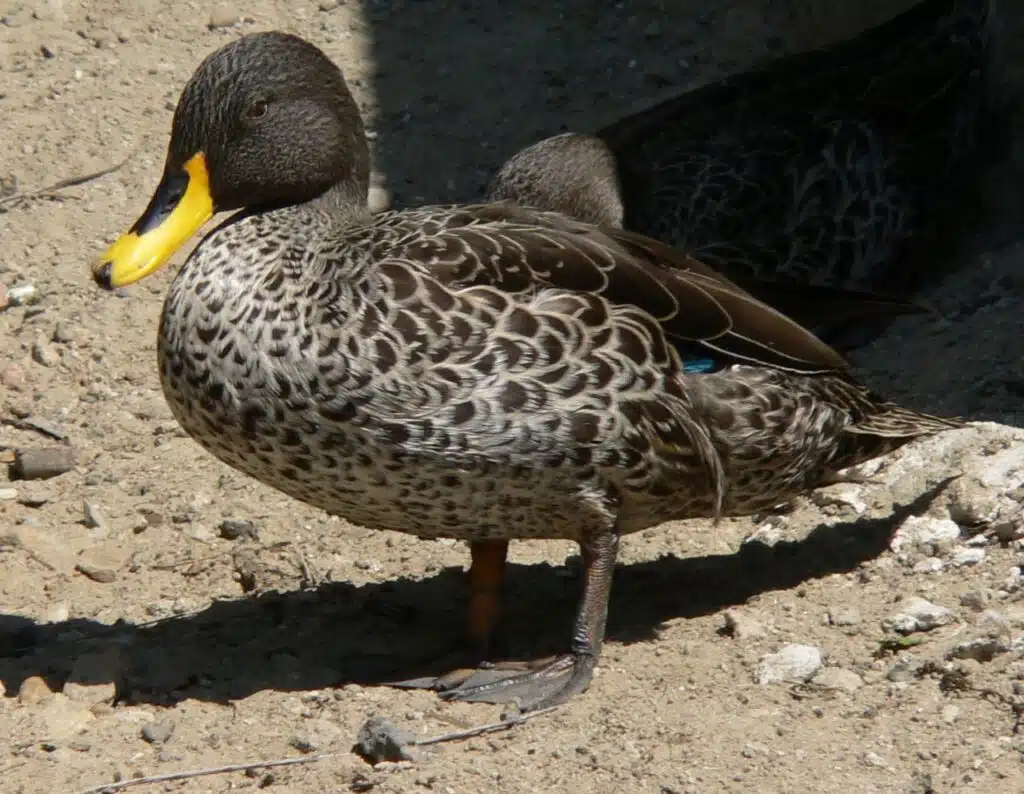
An African species, The Yellow-billed Duck (Anas undulata) is known for its different shades of gray.
Some of the nuances of the species are influenced by seasons while others are influenced by their gender.
Males are darker, showing different shades of gray across their bodies. They even show a dark gray to black head.
The rest of the plumage remains brighter gray and white.
Females are brighter, in general. They have gray heads and are often subject to predation, like males.
Some of the most difficult times for these ducks are during their molting. It’s at this time that the ducks lose their feathers and their capacity to fly and defend themselves from all types of predators.
Interesting fact – The average Yellow-billed Duck lives between 3 and 4 years.
Range – East Africa
11. Australian Shelduck
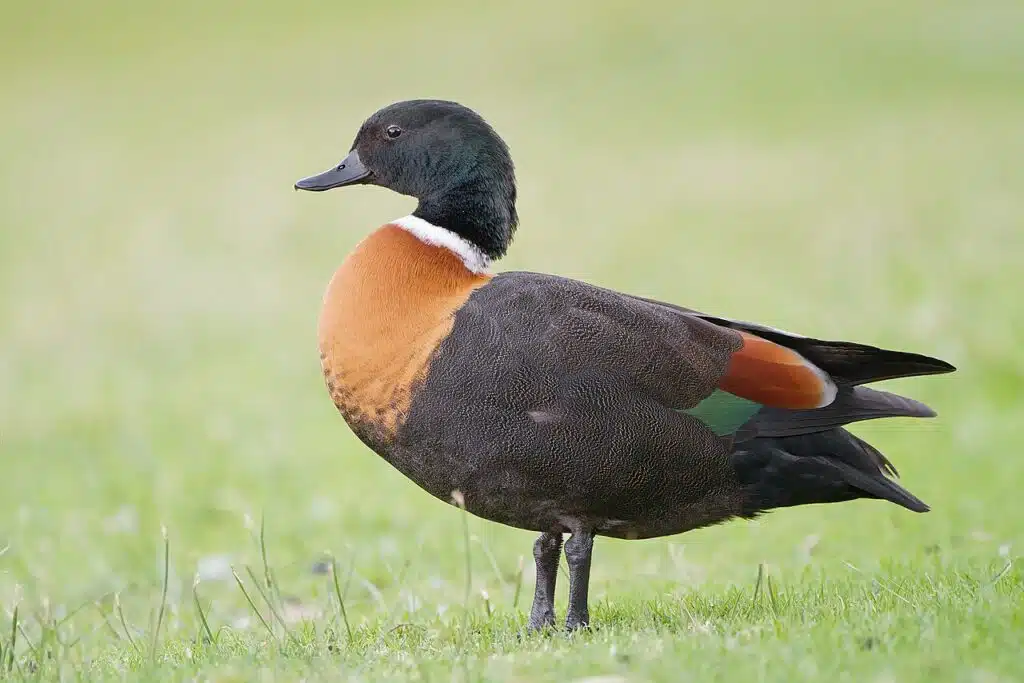
Similar to gooses, Australian Shelducks (Tadorna tadornoides) are known for their resemblance between males and females in terms of head coloring.
Both male and female Australian Shelducks share a black head. This black head base color is then contrasted by white sections, which are different for females and males.
The female duck has white rings around the eyes as well as a matching white band around the beak.
Males share a black head color but they lack the white rings around the eyes and beak. Instead, males have a white ring around the neck.
Apart from the head color itself, male and female Australian Shelducks share the same black beak color.
A red-brown chest is seen on both sexes. These types of ducks that resemble geese also share gray, black, white, and green patches along the wings.
Living in flocks around Southern Australia, these types of shelducks move their territories in the cooler months.
They are often spotted in arid areas in flocks. A typical Australian Shelduck flock can count anywhere between tens and thousands of individuals.
Interesting fact – Australian Shelducks can appear mostly white in their young stages.
Range – Southern Australia, Tasmania
12. Lake Duck
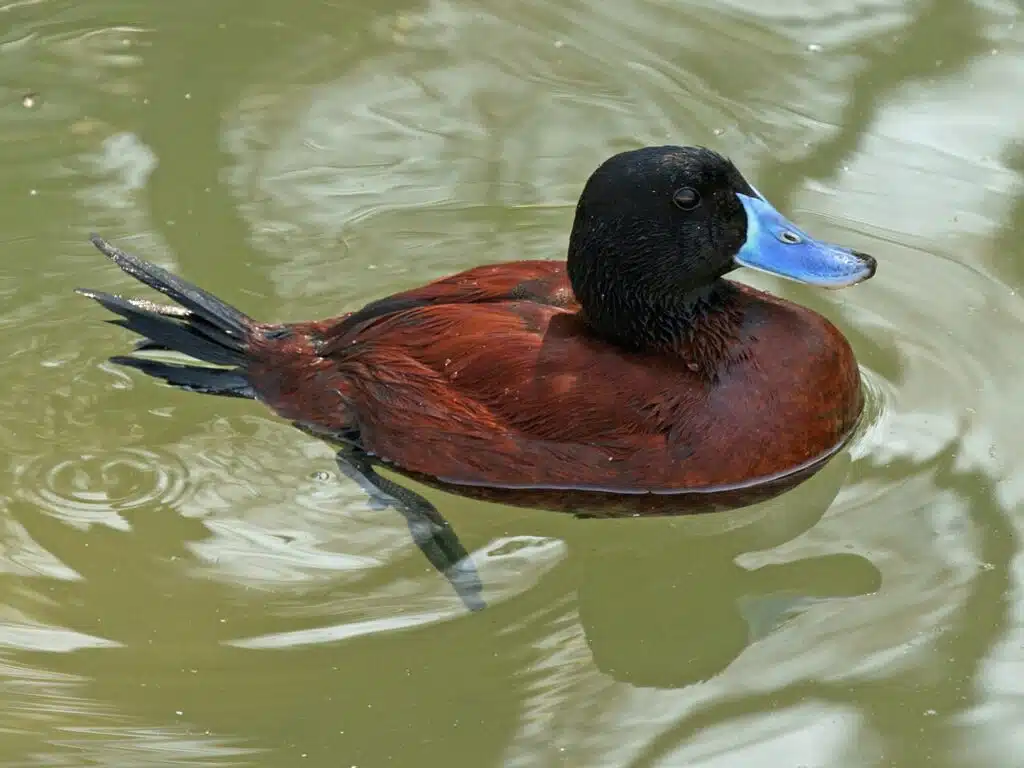
A species of South America, Lake Ducks (Oxyura vittata) are freshwater birds. They live on lakes, ponds, and water accumulations.
These types of ducks are found in the Southern parts of the continent, with a range that expands through multiple countries.
Also found in Argentina, Lake Ducks may further be known as Argentine Ducks.
This is a species that features a male with a black head. Uniform coloring is specific to the head which also shows a blue bill in the breeding season.
Red-brown plumage is further seen on males while the tip of their tails is black.
Females are less colorful and have mostly gray and white heads. The crown is gray while the white face is crested by gray bands.
A gray-billed female, the duck is considerably less colorful than the male.
Some of the best periods to spot the species include the end of January.
These birds may also be spotted feeding in small flocks. It’s believed they are omnivorous, with a preference for plants, insects, and invertebrates.
Interesting fact – Lack Ducks have established populations in some of the coolest regions of the world, such as Antarctica.
Range – South America
13. Andean Duck

Also a species of South America, Andean Ducks (Oxyura ferruginea) are some of the most numerous ducks with black heads in the world.
This is a species with a dual color. It has black and red-brown or chestnut colors with black being specific to its head and tail.
The head of the species is uniformly-black, without iridescence.
A bright blue beak is further distinguished on this species going into the breeding period.
Other physical traits are also distinct in the species. For example, Andean Ducks have erect black tails.
Their feeding habits are also distinct as Andean Ducks are diving ducks. As a diver, this species plunged into the water for food.
While it can fly, this type of duck is rarely seen flying. It’s rather known for its capacity to dive more than for its flying capacity.
Some Andean Ducks live in pairs, particularly during the breeding season. Others live in flocks with up to a few thousand individuals.
Interesting fact – Male and female Andean Ducks change their appearance for breeding success.
Range – Western South America
14. Blue-billed Duck
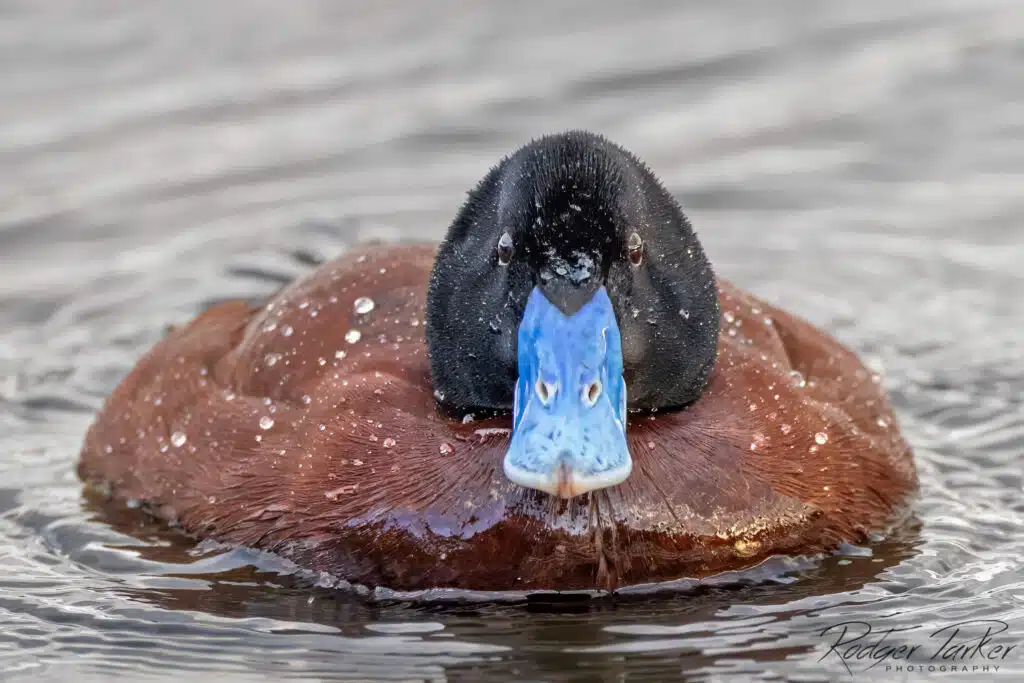
Named after the appearance of its blue bill, this duck species (Oxyura australis) is an Australian native.
It doesn’t live in the hottest parts of Australia or the tropical regions of Australia. This is a species that only lives in the temperate Southern parts of the continent.
This species is known for having males with blue bills. It is also a species that indicates the waters of its habitat are clean and used to establish the conservation status of an area.
Males of the species are characterized by their black heads and contrasting blue beaks. These are males that may be territorial in the breeding season.
Females have gray-brown heads and gray-white plumage. They lack the blue bill and the black head is seen on breeding males.
A species mostly feeding on invertebrates, these freshwater ducks spend almost all of their lives on the water.
The breeding season marks a period when these ducks live in male-female pairs.
As a result, some of the best times to spot these ducks are outside of the breeding season when they return to living in large flocks.
Interesting fact – These ducks feed on various water insects such as dragonflies.
Range – Southern Australia
15. Maccoa Duck
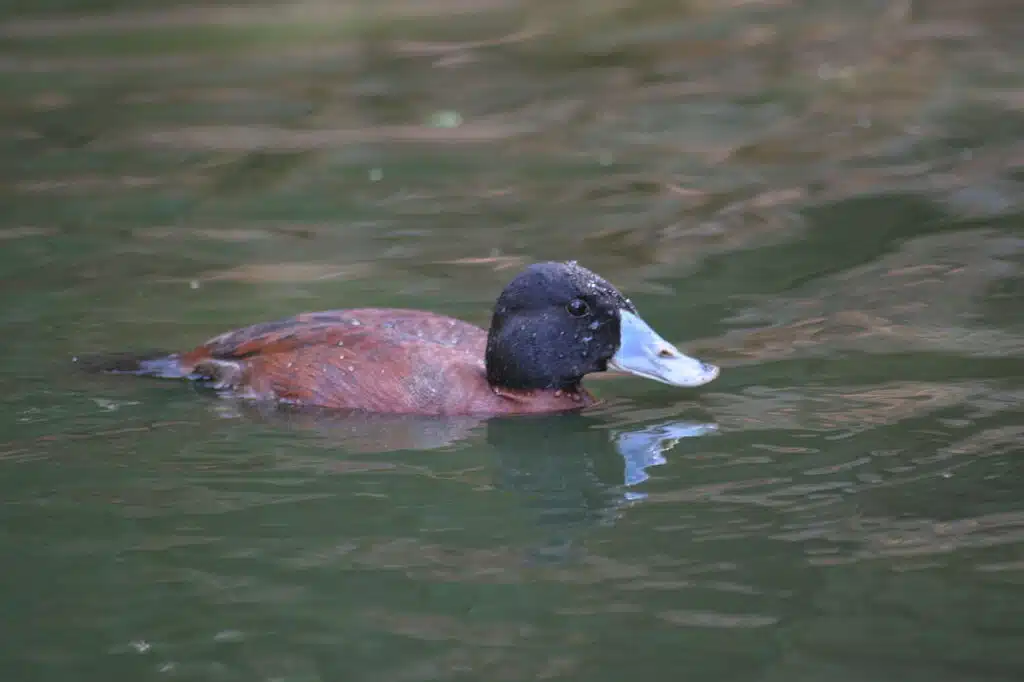
Another species with a black head only in the case of males is The Maccoa Duck (Oxyura maccoa).
These ducks are also found in South African climates plus in captivity around the world.
Males show a black head with a blue bill. They have chestnut-red plumage and a black upward-facing tail.
This is also a species with less colorful females, as with most types of ducks with black heads.
A South African species, Maccoa Ducks are found in high numbers just as they move into their breeding sites, at the beginning of the year.
These ducks are seen on the water, where they spend most of their lives. Adapted to living on water, they have their legs positioned further down the body which means they struggle to walk well when on land.
In terms of food, they can feed on various plants and insects they find on water, including insect larvae.
Much of the feeding and breeding range of these ducks are tied to areas of water close to land, where species such as bulrush grow.
Interesting fact – Maccoa ducks prefer to live in areas with dense reed growth.
Range – South Africa
16. New Zealand Scaup
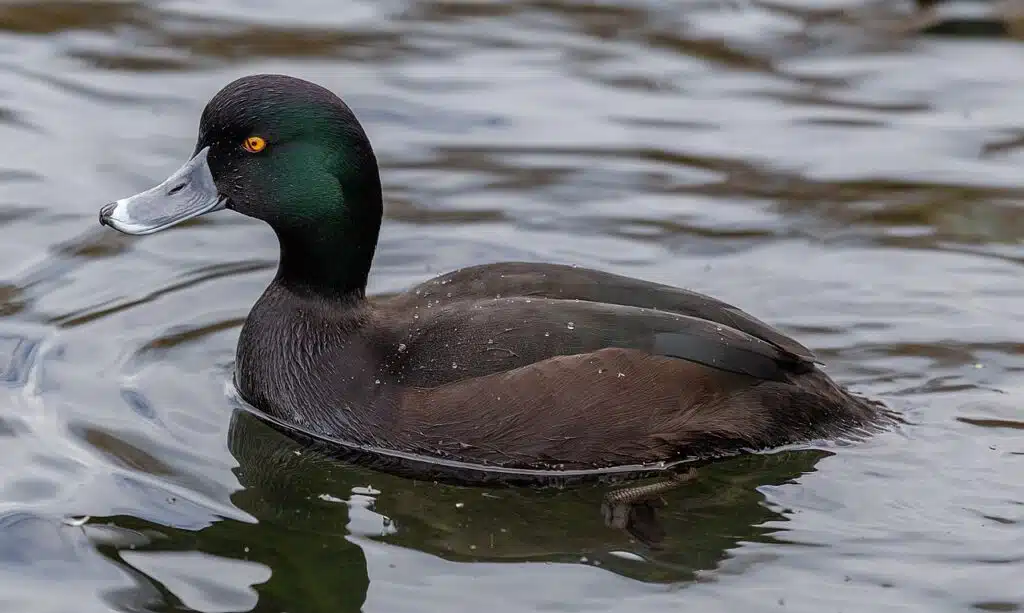
A New Zealand native, this type of duck (Aythya novaeseelandiae) is well-documented. It turns out these species are highly territorial and aggressive.
Males of the species become the most aggressive going into the breeding season.
A male New Zealand Scaup can be identified by its black head with a type of green tint. This is a hue that may only be visible in direct sunlight.
Bright yellow eyes are also seen on males, which are also ducks with gray beaks.
Brown and black colors dominate their plumage.
Females are dark brown to black but are generally brighter than males and responsible for laying eggs and building nests.
Both males and females can dive several feet for food such as fish and mollusks.
Interesting fact – New Zealand Scaup can hold breath for up to 1 minute underwater.
Range – New Zealand